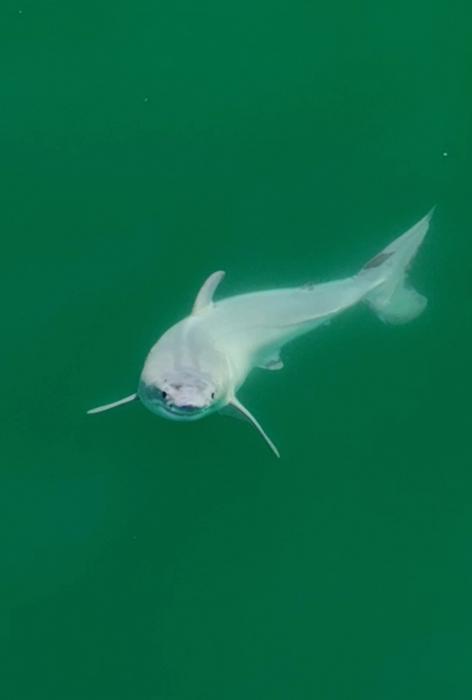Great whites, the largest predatory sharks in the world with the most fatal attacks on humans, are tough to imagine as newborn babies. That is partially because no one has seen one in the wild, it seems, until now.

Credit: Carlos Gauna/The Malibu Artist
Great whites, the largest predatory sharks in the world with the most fatal attacks on humans, are tough to imagine as newborn babies. That is partially because no one has seen one in the wild, it seems, until now.
Wildlife filmmaker Carlos Gauna and UC Riverside biology doctoral student Phillip Sternes were scanning the waters for sharks on July 9, 2023, near Santa Barbara on California’s central coast. That day, something exciting appeared on the viewfinder of Gauna’s drone camera. It was a shark pup unlike any they’d ever seen.
Great whites, referred to only as white sharks by scientists, are gray on top and white on the bottom. But this roughly 5-foot-long shark was pure white.
“We enlarged the images, put them in slow motion, and realized the white layer was being shed from the body as it was swimming,” Sternes said. “I believe it was a newborn white shark shedding its embryonic layer.”
These observations are documented in a new paper in the Environmental Biology of Fishes journal. The paper also details the significance of having seen a live newborn white shark.
Gauna is known online as The Malibu Artist. He has spent thousands of hours filming sharks around the world, and his videos of them swimming close to beachgoers have millions of views. What he and Sternes observed could help solve the longstanding mystery of great white birthing habits.
“Where white sharks give birth is one of the holy grails of shark science. No one has ever been able to pinpoint where they are born, nor has anyone seen a newborn baby shark alive,” Gauna said. “There have been dead white sharks found inside deceased pregnant mothers. But nothing like this.”
Though the paper authors acknowledge it is possible the white film the shark shed could have been a skin condition, the duo do not believe this to be the case. “If that is what we saw, then that too is monumental because no such condition has ever been reported for these sharks,” Gauna said.
For many reasons, the duo believes what they saw was in fact a newborn great white.
First, great white females give birth to live pups. While in utero, the embryonic sharks might feed on unfertilized eggs for protein. The mothers offer additional nourishment to the growing shark pups with a ‘milk’ secreted in the uterus.
“I believe what we saw was the baby shedding the intrauterine milk,” Sternes said.
A second reason is the presence of large, likely pregnant great whites in this location. Gauna had observed them here in previous years, and in the weeks leading up to the observation. “I filmed three very large sharks that appeared pregnant at this specific location in the days prior. On this day, one of them dove down, and not long afterwards, this fully white shark appears,” Gauna said. “It’s not a stretch to deduce where the baby came from.”
Thirdly, the shark’s size and shape are also indicative of a newborn. What the two observed was thin, short, and rounded. “In my opinion, this one was likely hours, maybe one day old at most,” Sternes said.
Finally, this location off the coast of central California has long been proposed as a birthing location for great whites. “There are a lot of hypothetical areas, but despite intense interest in these sharks, no one’s seen a birth or a newborn pup in the wild,” Sternes said. “This may well be the first evidence we have of a pup in the wild, making this a definitive birthing location.”
Many scholars believe great whites are born farther out at sea. That this pup was filmed so close to shore — roughly 1,000 feet from the beach — is significant because its age means it was likely born in shallow waters.
Great whites are listed as an international endangered species. “Further research is needed to confirm these waters are indeed a great white breeding ground. But if it does, we would want lawmakers to step in and protect these waters to help white sharks keep thriving,” Sternes said.
Journal
Environmental Biology of Fishes
DOI
10.1007/s10641-024-01512-7
Article Title
Novel aerial observations of a possible newborn white shark (Carcharodon carcharias) in Southern California
Article Publication Date
29-Jan-2024




